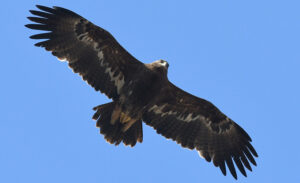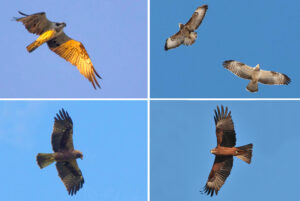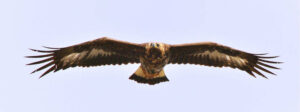Third International Scientific and Practical Conference “Eagles of the Palearctic: Study and Conservation”
Raptors Conservation. Suppl. 2. Proceedings of Conferences
Migration of Birds of Prey Through The Western Caucasus in Autumn
Perevozov A.G. (Caucasian State Nature Biosphere Reserve, Maykop, Russia)
Contact:
Alexander Perevozov perevozov-kgz@mail.ru
Recommended citation: Perevozov A.G. Migration of Birds of Prey Through The Western Caucasus in Autumn. – Raptors Conservation. 2023. S2: 202–206. DOI: 10.19074/1814-8654-2023- 2-202-206 URL: http://rrrcn.ru/en/archives/35027
Research took place in the Caucasian Nature Reserve and its environs in 2006–2022 in periods from August to November during expeditions and at stations.
Raptor migration in the study area occurs across a wide area, with greater intensity in the Malaya Laba River valley. Agricultural fields are located in foothill locations, where birds rest and feed in case of bad weather at higher elevations, and when conditions improve, continuing over the Main Caucasian Range. Flocks of raptors are best seen when the observer is in the foothills or alpine zones altitudes of 1800–3000 m above sea level. Birds of prey are largely invisible when sought from the vantage point of forest meadows located 500–1700 m above sea level, landing there very rarely and only under extremely unfavorable conditions or if injured.
During autumn migration (August-November) from 2006 to 2022, 20,780 individuals of birds of prey belonging to 27 species were counted. Almost all of these species are migratory to some extent, with the exception of Bearded Vulture (Gypaetus barbatus) (64 individuals counted) and Golden Eagle (Aquila chrysaetos) (18), both strictly sedentary. Even a portion of the Griffon Vulture (Gyps fulvus) (54) and Black Vulture (Aegypius monachus) (14) populations migrate and can occasionally be observed intentionally flying with flocks of Common Buzzards (Buteo buteo) and Black Kites (Milvus migrans).
The most intensive migration was recorded in 2009 (11,685 individuals), 2021 (3,229), 2022 (2,213), and 2018 (1,378). In 2007 and 2014, no migration was observed. In 2008, 2015, and 2017, fewer than 100 individuals were counted. In other years, between 100 and 1,000 individuals were counted. Migration occurs in waves; the population peaks in clear weather immediately after prolonged rains and snowfalls, not uncommon events in the mountains in September and October. There is no guarantee of observing intensive migration every year, given that expeditions sometimes happen in adverse weather conditions. In those instances, we have occasionally seen the phenomenon of reverse migration, when birds flying along the river valley stumble upon an insurmountable veil of clouds and turn back.
The most widespread species is the Common Buzzard – 15,630 individual sightings, of which about 10,000 were counted on 30/09/2009 between morning and noon. On 24/09/2009, 700 individuals were counted in one flock, and 26/09/2009 900 individuals were counted. Large aggregations were recorded 02/10/2016 (300 birds); 27/09/2018 (410); 28/09/2018 (300); 29/09/2021 (750); 02/10/2022 (436). The vast majority are Common Buzzards of the steppe subspecies B. b. vulpinus.
The second most abundant species is the Black Kite. A total of 3,680 individuals were counted, of which 2,063 individuals were counted in 2021 and 1,304 individuals in 2022. Large aggregations were observed 01.10.2011 (300 individuals), 29/09/2021 (410), 24/09/2021 (1,500), 26/09/2022 (965), and 02/10/2022 (280).
The third most abundant species is the common European Honey Buzzard (Pernis apivorus). A total of 619 individuals were counted, of which 518 individuals were counted in 2018. They fly singly (n=8) or in flocks (n=22) up to 34 individuals, 15 individuals on average.
105 Sparrowhawks (Accipiter nisus) individuals were counted. They fly singly or in pairs in clusters of other birds of prey or separately.
An encounter of a cluster comprising roughly 100 Steppe Eagles (Aquila nipalensis) on 10.06.2022 in the foothills was notable. Over the rest of that same period, only one individual was observed on 21.08.2018.
The number of all other species totals fewer than 100 individuals over 17 years of observations: Lesser Spotted Eagle (Aquila pomarina) – 93; Western Marsh Harrier (Circus aeruginosus) – 78; Montagu's Harrier (Circus pygargus) – 23; Pallid Harrier (Circus macrourus) – 20; Booted Eagle (Hieraaetus pennatus) – 13; Northern Goshawk (Accipiter gentilis) – 13; Hen Harrier (Circus cyaneus) – Fewer than 10 individuals of the following species were recorded: White-Tailed Eagle (Haliaeetus albicilla), Long-Legged Buzzard (Buteo rufinus), Greater Spotted Eagle (Aquila clanga), Eastern Imperial Eagle (Aquila heliaca), Short-Toed Snake Eagle (Circaetus gallicus), Osprey (Pandion haliaetus), and Lesser Kestrel (Falco naumanni).
This is the phenology of migration in general terms: migration begins in mid-August with the appearance of European Honey Buzzards. Booted Eagles, Marsh and Montagu's Harriers, Black Kites and Common Buzzards fly sporadically in that same time frame. From mid-September to mid-October, Common Buzzards and Black Kites are at peak migration. In species such as Marsh Harrier, Black Kite, Common Buzzard, Sparrowhawk, Booted Eagle, Lesser Spotted Eagle, and Pallid Harrier, migration is extended over the entire autumn period. For European Honey Buzzards and Montagu's Harriers migration takes place over a short 1–2 week period.
The results obtained indicate a large migratory flow of raptors passing through Western Caucasus in autumn. Our data cover only a small part of this flow – we censused for just 2–3 weeks of the 3-month fall migration, and only a small portion of migrating birds can be observed from a single point. By our estimates, over 100,000 raptors fly through the Caucasian Reserve in a single autumn season. To obtain more detailed and complete data, fixed site censuses must occur throughout the entire migration period, conducted by a research group working in shifts. The Malaya Laba River valley is clearly visible from the western slope of Mount Yatyrgvarta making it a potentially suitable location for a census station.

Steppe Eagle (Aquila nipalensis) on its migration through the North Caucasus. Photo by R. Bekmansurov.

Osprey (Pandion haliaetus) – upper at the left, Booted Eagle (Hieraaetus pennatus) bottom at the left, Honey Buzzard (Pernis apivorus) and Common Buzzard (Buteo buteo) – upper at the right, Black Kite (Milvus migrans) bottom at the right. Photos by A. Perevozov.

